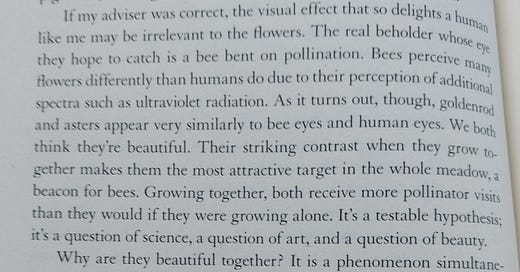Welcome to our first Lectio Sweetgrass group. This book is so chockful of wisdom, I thought it would be great to break it down into bite-sized pieces to enjoy a more contemplative discussion. The format of the discussion is based on the Catholic practice of Lectio Divina, which is a meditative way of reading scripture, but of course, Braiding Sweetgrass is a non-denominational text and all are welcome. You many want a cup of tea or journal (if you like to write down your answers to the discussion questions) to accompany you as you read.
I chose this passage because, in my neck of the woods, we are just at the very beginning of goldenrod and aster season, and I wanted to get myself ready to behold it. Here are a few questions to guide you. I encourage you to follow the below procedure, but that’s not rigid instruction. Engage with the text in a way that feels nourishing for you.
Read the passage
Contemplate the first question: What is one word or phrase you are drawn to?
Sit quietly for 2-5 minutes
Read the passage again
Contemplate the second set of questions:
What do you feel?
What are your emotions?
What specific situation in your life relates to this passage?
Sit quietly again
Read the passage
Contemplate the third question: What do you feel called to after reading this passage?
Comments: To keep the discussion of each question a little easier to follow in the comments, it may be helpful to start your comment with 1, 2, or 3 for which question you are answering. Or if the passage brought up an interesting thought or question for you that is not directly related to the questions, please use OTHER:
Blessings to you, and my humble gratitude for joining me in geeking/whatever the spiritual equivalent of geeking is out on Robin Wall Kimmerer.





3.
-Practice seeing through other eyes
-Find those with whom we can mutually be pollinated more than if we were growing alone.
-Behold the shimmering threads that hold it all together
-Help others love the world and rock back on their heels in awe.
OTHER: I love biology and it helps me to connect to the enchantment of the natural and often overlooked/mundane world around me but don't often remember to really look at and see. That passage is an important one for me. I first read it five years ago.. It was the first time I considered the pairing of yellow and purple blossoms and realised that we have similar pairings of native plants in Australia. In my region, early spring (the season we're now in) is marked by the profuse brilliant yellow puff-ball blossoms of the Silver wattle (Acacia dealbata) and Cootamundra wattle (Acacia baileyana), at the same time the False Sarsparilla Vine, also called 'Happy Wanderer'; (Hardenbergia violacea) blooms in waves of purple. The honey bee is not native so revisiting this passage prompted me to research the native pollinators of these plants as I had no knowledge about this.
Apparently... "Wattles are opportunistic pollinators making the most of pretty much any beetle, wasp or bee which lands on them to do the job of spreading their genes around. Unlike many other plants, most wattles do not rely on a specific type of insect or bird for pollination. Instead, insects land on the blossom and become covered with pollen, carrying it from one plant to the next. Birds which forage for these insects also become incidental pollen carriers in the process." (ABC Science). They don't have nectar but their pollen is full of protein. They also exude a sticky, sweet substance on their leaves when they flower, which attracts birds, especially the honey-eater (Meliphagidae).
The Happy Wanderer is pollinated by native bees including the lovely Blue Banded Bee (Amegilla spp.), as well as the introduced honey bees. I couldn't find much else about it so my curiosity is not yet satisfied.
This passage has reminded me to reawaken my curiosity about the world around me and to see the 'umwelt' - the world through the eyes of other organisms (a concept I learned through another book I have recently finished, "Wild Signs and Star Paths" by Tristan Gooley").
Thanks for the wonderful prompt Amy and to all the commenters for your own umwelt (perspectives).